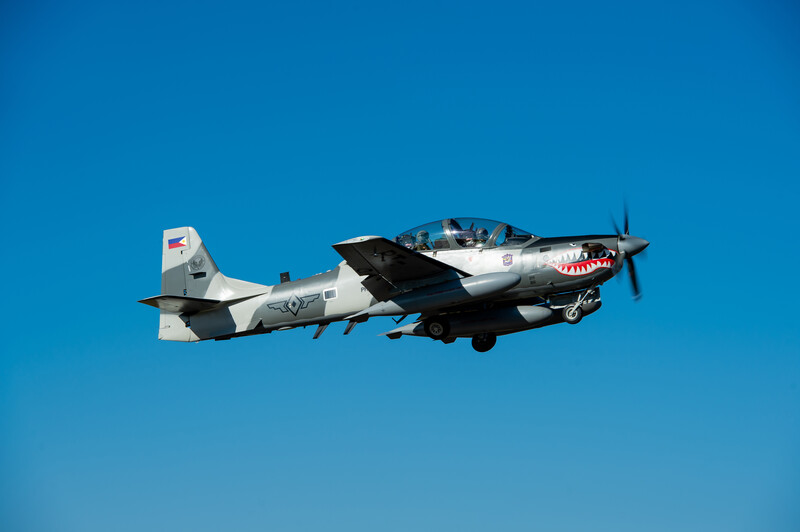Two Chinese People’s Liberation Army – Air Force (PLA-AF) fighter jets were observed closely circling a Philippine aircraft deployed as part of the joint bilateral maritime patrol with Australia in the West Philippine Sea.
The Chief of Staff of the Armed Forces of the Philippines (AFP), General Romeo Brawner Jr., revealed that on November 26, two Chinese jets encircled the Philippine Air Force’s A-29B Super Tucano – a light attack, combat and reconnaissance aircraft – for approximately 15 minutes.
ABS-CBN, a Filipino media outlet, also released a video capturing the incident. However, it remains challenging to identify the specific Chinese People’s Liberation Army (PLA) jets that engaged with the Philippine Air Force (PAF).
In response to inquiries regarding the joint patrol exercise’s progress with Australia, the Chief of the Armed Forces of the Philippines (AFP) reassured that everything was proceeding smoothly, devoid of any untoward incidents.
General Brawner elaborated, “Two Chinese jet fighters circled our plane. They just circled.” He said that the Philippine aircraft experienced shadowing by the two Chinese jets while navigating the vicinity of Hubo Reef.
WATCH: Two Chinese fighter jets orbited a Philippine aircraft during the joint patrols of the Philippines and Australia in the West Philippine Sea on Sunday.
(📹 AFP Public Affairs Office) @ABSCBNNews pic.twitter.com/ID8ZalmCNG
— Bianca Dava 🐱 (@biancadava) November 27, 2023
Despite the surveillance conducted by the Chinese aircraft, he confirmed that the Super Tucano completed its air and maritime patrol mission following the designated flight path.
General Brawner also revealed that no Australian aircraft encountered similar shadowing from the Chinese People’s Liberation Army (PLA) jet fighters.
Australia’s defense department is yet to comment on the incident. However, Andrew Greene, an ABC Defence Correspondent, reported that sources in the Philippines indicate that the Royal Australian Air Force’s (RAAF) P-8 was in another patrol sector when the incident occurred.
Brawner highlighted the exercise as asserting their right to conduct patrols jointly with allies, adhering to international laws such as the United Nations Convention on the Law of the Sea (UNCLOS) and the rule of law.

The AFP had previously disclosed the participation of two Philippine Air Force A-29B Super Tucanos in the Philippine-Australia Maritime Cooperation Activity alongside the Australian Defense Force over the weekend.
Growing Tensions Between Philippines And China
The military forces of the Philippines and Australia conducted joint sea and air exercises within the exclusive economic zone of the Southeast Asian nation.
This comes shortly after Manila engaged in patrols with the United States, reflecting the concerns of Pacific nations monitoring an increasingly assertive China.
China asserts control over the South China Sea, a vital conduit for more than US$3 trillion in annual ship-borne trade. However, this claim is disputed by several countries in the region, including the Philippines, Vietnam, Indonesia, Malaysia, and Brunei.
In 2016, the Permanent Court of Arbitration ruled that China’s South China Sea claims lacked a legal basis. This decision has been a focal point in the region’s ongoing geopolitical tensions and territorial disputes.
Meanwhile, the Philippines is intensifying its measures to counter what it perceives as China’s “aggressive activities” in the South China Sea. The region has become a hotspot for tensions between China and the United States regarding naval operations.
China, in response, has accused the Philippines of involving “foreign forces” in patrols across the South China Sea, alleging that these actions are causing disturbances in the region.
The incident involving a Philippine aircraft and two Chinese jets adds to the escalating tensions between Manila and Beijing.
This situation unfolds against an intensifying stand-off over the regular resupply missions conducted by the Philippine military to its outpost on Second Thomas Shoal, a sandbank in the South China Sea.
Collin Koh, a research fellow at the S. Rajaratnam School of International Studies in Singapore, weighed in on the latest incident involving Chinese fighters and a Philippine aircraft.
Koh pointed out that although the distance observed during this incident was considered safe, he expressed concern about past behaviors exhibited by People’s Liberation Army (PLA) aviators and their commanding officers.
Koh highlighted a worrying trend of the Chinese jets steadily reducing the gap with other nations’ aircraft, hinting at the potential for heightened tensions in future encounters.
In recent years, Beijing has heightened its aerial activities near Taiwan. Although Taiwan routinely issues updates on Chinese military aircraft near its borders, it does not offer aerial visuals akin to the recent disclosure by the Philippines.
Ben Lewis, a defense expert based in Washington, highlighted this discrepancy, stating that the Philippines’ proactive approach in publicizing such incidents serves as a model that Taiwan should consider emulating.
Recognizing the identical challenges faced by Taiwan and the Philippines, Lewis suggested that Taipei adopt similar transparency in communicating and addressing these concerns.
- Contact the author at ashishmichel(at)gmail.com
- Follow EurAsian Times on Google News